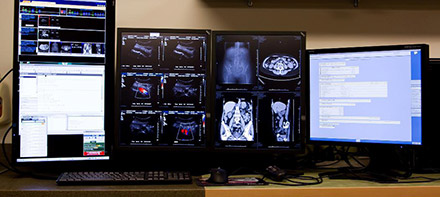NEC Display Solutions Client Installation Healthcare
POUDRE VALLEY HEALTH SYSTEM
POUDRE VALLEY HEALTH SYSTEM UPGRADES ITS MEDICAL IMAGING WITH NEC DISPLAYS
Accuracy in digital radiological imaging is critical for everyone involved. The medical staff needs to know exactly what is on the screen so they can provide a better diagnosis to the patients, who in turn need to know the correct results for their own well-being and peace of mind. From beginning to end, understanding the image is important, and since opening its doors in 1925, the USA’s Poudre Valley Health System has put the utmost emphasis on patient care and accuracy.
Patients come to Poudre Valley’s three Colorado locations for general and specific healthcare needs. The accuracy of each case comes from not only its physicians’ training and expertise, but also from the clarity and precision of the tools with which it works.
The Challenge
In 2006, Poudre Valley’s radiology department was fitted out with NEC displays. This project included 21.3” MultiSync MD21GS- 3MP grayscale models the staff used to read and interpret images for patients. They loved the equipment because it gave them a clear image to work with when diagnosing patients. The reliability of the equipment allowed them to use the displays all day, every day, without problems. This was an essential component as the imaging equipment at Poudre Valley get heavy use.
As the years passed, the displays were used for everything from MRIs to CT scans to X-rays—that required high-performance durability and consistent image clarity. While the grayscale displays met those criteria, the radiologists realized they needed more.
“With continual developments in technology and the precision expected by our patients, we realized in 2011 that it was time to refresh our diagnostic imaging displays to keep up,” explained Gregg Highbloom, a PACS administrator with Poudre Valley. “The NEC products we had worked great within their limitations, but we needed an update. Considering how often we use our displays, we wanted to make sure they were the best out there.”

The healthcare industry trend dictated a move from grayscale to color displays. While the grayscale readouts were still sufficient for some testing, color would provide a more indepth look during critical tests. It is especially important for ultrasounds and Doppler imaging, both of which are used with conditions where there can be serious consequences if the information is read incorrectly. Poudre Valley’s radiologists wanted a product that could not only work in prenatal situations with pregnant women, but any time they needed to get a detailed look at internal organs. The color ultrasound would provide the level of precision that the grayscale couldn’t, preventing a possible misinterpretation, or worse, a misdiagnosis.
Doppler imaging is just as critical and requires color in the same way ultrasounds do. Typically, it is used to study blood and the arteries, both of which require meticulousness and incredible attention to small details. The better the equipment, the better care the staff can provide to patients.
“Color isn’t a luxury in medical imaging at this point…it’s a necessity,” said Highbloom.

The NEC Solution
Knowing that a durable, color display with precise imaging abilities was necessary, Poudre Valley management didn’t have to go far to determine what would be best for its staff.
“We had great success with our last products from NEC, so it was a natural fit to look to them again,” said Highbloom. “We knew the quality and reliability of the products and that the cost was about two-thirds less than the competitors’. NEC’s customer support had always been responsive as well. We’d developed a very strong relationship with NEC, too. They had everything we wanted.”
NEC’s Stan Swiderski, business development manager for professional and medical displays, helped coordinate the project—from consultation and design layout to choosing the displays and video cards—as well as providing answers regarding the five-year standard warranty.
Poudre Valley management decided to purchase 15 21.3” MultiSync LCD2190UXp professional-grade navigation monitors and 30 21.3” MD213MC diagnostic displays. Poudre Valley set up workstations that each featured three displays. A navigation screen to switch between programs is connected to a standard video card, and two diagnostic displays are set up in portrait orientation using the NEC-recommended Nvidia Quadro 2000D video cards, which allow staff to view and read CT scans, ultrasounds, Doppler and other images.
“The Poudre Valley staff immediately commented on the ease of use and quality of its existing monitors,” said Swiderski. “We reviewed several different models, all of which came with full medical-grade certifications and sensory technology upfront, so it made their jobs easier and the work more precise.”
The project to convert from grayscale to color began in the summer 2011, with installations complete by January 2012. Immediately, the staff noticed a difference.
“The displays’ technology blends perfectly with what we’re trying to do,” said Highbloom. “The ease of calibration and the accuracy of the color screens in the diagnostic settings proved to us that we made the right choice. The displays provide the accuracy we need in the lighting and space we had already. It was a seamless installation.”
The upgraded displays also feature built-in front calibration sensors that ensure image brightness stability and color consistency for the life of the display.
“There’s a real confidence in our work,” Highbloom says. “The staff knows when they look at the images, they’re really seeing the patient. That’s what will provide the best care for the people who come to Poudre Valley Health System.”
Since Poudre Valley radiologists open many programs simultaneously, management wanted to add a fourth display to each workstation. The need for a large screen size to view more open applications validated a purchase of multiple 27” MultiSync EA273WM monitors in mid-2012, which are used as navigation monitors and allow staff to pull up electronic medical records.


